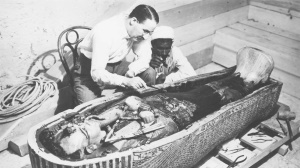|
A MESSAGE FROM H. CARTER
Greetings to the reader of this brief document, published for the first time after many years from the date it was written. The date that I, Howard Carter, archaeologist and Egyptologist, chose for its presentation is today: November 27th, 2022, exactly one hundred years from the official opening ceremony, in the Valley of the Kings, of the KV62's first chamber, the tomb of Tutankhamun, as the world would have known in a short time. I'm writing
these lines to bring to light at last some matters concerning my achievements,
through time mooted, challenged and even publicly distrusted. The first one is important both for my role as a scholar blessed by worldwide fame (maybe not entirely deserved), and - above all - for my conscience, which continued to torment me during decades, fierce and relentless, to the point of me thinking about committing suicide. The second reason is more problematic, and is intended to bring into the open a conundrum connected with my discovery of KV62; an enigma of which I was the only one aware, an enigma that at the time I failed to unveil because it would have put a bad light in everything I was conveying to the archeological community worldwide. 1 - In 1922, my November 6th cable to friend and patron Lord Carnarvon, in which I was inviting him to come back to Egypt to attend with me the official opening ceremony of the tomb, said "AT LAST HAVE MADE WONDERFUL DISCOVERY IN VALLEY; A MAGNIFICENT TOMB WITH SEALS INTACT; RE-COVERED SAME FOR YOUR ARRIVAL; CONGRATULATIONS. H.". Actually two weeks later, throughout the cleaning procedures in the entrance area, the tomb's seals were NOT found intact and this should have been an out-and-out blow to the heart to Lord Carnarvon and his beloved daughter Evelyn, who was there with him. I was not surprised. |
 |
|
Only now I openly confess, with the safe distance of one hundred years, that I broke the Tutankhamun's tomb seals on the night of November 4th, 1922, at 11,30 p.m.. At that time, alone and without anyone knowing, I went on the dig place with the aim of calming down in some way the dreadful anxiety that was consuming me in those frenzied weeks. Therefore, the seals' baffling breaks (which in that context should have been broken only in the presence of official Egyptian authorities), at first stated intact and then found inexplicably broken, has been clarified, even though a century late. 2 - The second
element my confession wants to bring to light is more complex, incomprehensible
and terribly painful to me, its sole holder. In the night of November 4th, by the light of a small torch, fevered, while I was prowling through decorated sarcophaguses, life size statues and golden chariots, a small wooden object hidden behind some grave goods caught my attention. At first I wasn't struck by its richness or its unusual aspect, but rather by the signs engraved on the side lighted by my torch: they were not late demotic hieroglyphs like the other inscriptions all around me at that moment. They were simple, accurate alphabetic characters, composing an inscription incredibly easy and absurd and terrifying to read, "Franz Anton Ketterer fecit, Schoenwald 1735". I must confess I remained still there for a very long time, half an hour, maybe more, trying to find some kind of logical explanations, just any kind that could give meaning to the nightmare I was experiencing. Useless. Shortly after, an atrocious doubt began emerging: that thing, and that inscription could NOT be there, should NOT be there at that time. They'd have eclipsed, indeed completely annihilated my findings' value, they'd have been at the core of all articles, studies, lectures for many years. They'd have sparked ironic giggles among my esteemed colleagues and majestic scholars, definitely dragging my long and difficult years of research into ridiculous and humiliation. I went back to my tent at dawn, the small object carefully concealed into my shoulder bag. After
a few months the cuckoo clock found its place at my Collingham Gardens
study in London, daily memento of the absurd, of the insanity that devastated
my life that November 4th, 1922." |